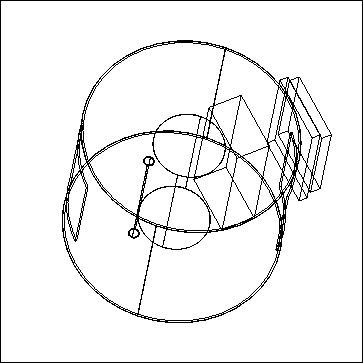The geometric reconstruction of the liquid hydrogen target used in the measurements and
Monte Carlo simulation is shown in Fig. 2.6. The target housing
encloses a cylindrical volume
of liquid hydrogen, of radius 2 cm and height 8 cm. The liquid hydrogen sits
in a cylindrically shaped mylar container of wall thickness 150 ![]() m.. The mylar
container is surrounded by vacuum, which is enclosed by an aluminum cylindrical housing
of inner radius 6.0 cm and wall thickness 1 mm. In the path of the incident beam
is a 2 cm thick CH
m.. The mylar
container is surrounded by vacuum, which is enclosed by an aluminum cylindrical housing
of inner radius 6.0 cm and wall thickness 1 mm. In the path of the incident beam
is a 2 cm thick CH![]() degrader and 2.4 cm of
degrader and 2.4 cm of ![]() C degrader. This configuration
of degraders produces the maximum stopping rate for pions in the liquid hydrogen
target.
C degrader. This configuration
of degraders produces the maximum stopping rate for pions in the liquid hydrogen
target.

Figure: Geometric reconstruction of the liquid hydrogen target used in
the GEANT simulation of the Panofsky Ratio measurement. The
liquid hydrogen is contained in the aluminum cylindrical object in the center.
the rectangular objects are a series of carbon degraders which ensure that
the 116 MeV/c ![]() beam stops approximately in the center of the liquid
hydrogen.
beam stops approximately in the center of the liquid
hydrogen.
The beam counter B0 is a thin plastic scintillator, placed immediately before
the quadrupole magnet in the ![]() area. The beam counter B1 is a thin plastic
``pill'' shaped counter, placed between the quadrupole and the liquid hydrogen target.
It is attached to the 2.4 cm of
area. The beam counter B1 is a thin plastic
``pill'' shaped counter, placed between the quadrupole and the liquid hydrogen target.
It is attached to the 2.4 cm of ![]() C degrader described in the previous paragraph.
Its active area is 1
C degrader described in the previous paragraph.
Its active area is 1![]() 1 cm, with a thickness of 0.2 cm.
1 cm, with a thickness of 0.2 cm.